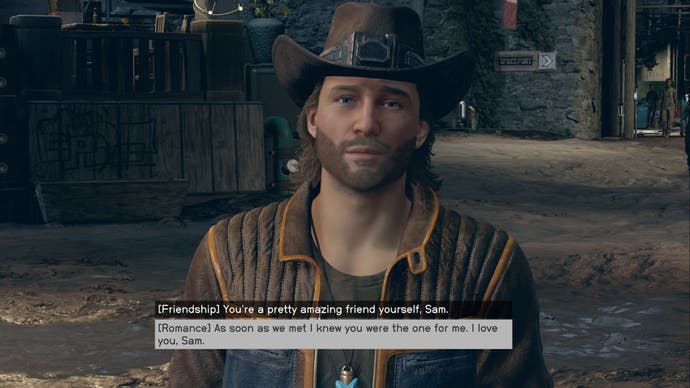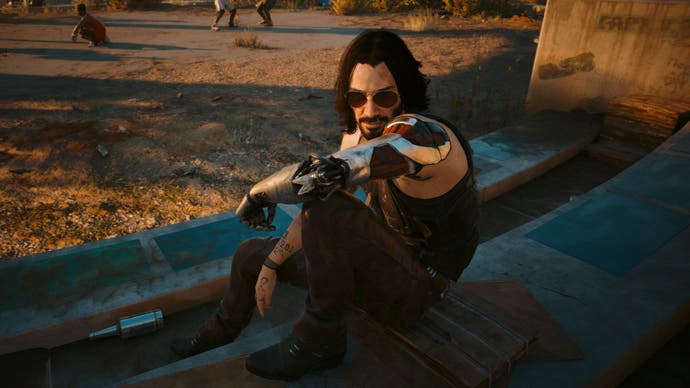Cyberpunk's storytelling makes Starfield seem ancient
Performance art.
I'm jumping to a new planet in Starfield and my space cowboy companion Sam Coe needs to have a serious conversation. He launches into a long story about his estranged partner but he's facing the wrong way. Stuck on a ladder in the middle of my ship, he tells his sad tale to a blank wall.
Restarting the conversation helps a little. Sam is looking at me now, but his mouth and eyebrows are operating on different wavelengths. Occasionally his face settles on a recognisable expression, but the in-between moments - as he reorganises his wayward features - are deeply strange. All the while he stands stock-still and completely upright, like a toy soldier stuck in his plastic packaging.
Like all of Starfield's characters, he does not touch anything, or anyone. He does not eat. He does not use the bathroom. Sam Coe rotates on the spot and delivers his lines until the next stage of his personal side quest unlocks. Sam Coe is a horrible, distorted facsimile of a human being.

Starfield's stilted performances have broken the game for me. It suffers terribly in comparison with Cyberpunk's rich cast of irreverent characters, who are connected to their environment: moving around, sitting down, pouring shots, brandishing weapons. They can be surprising, sometimes. One random side gig briefing takes place in the front seats of a car, horizontally reclined, because your novice spy contact thinks that's the best way to hide in a vehicle.
Small things make a huge difference, like cross-talk between characters. Sure, it can feel a bit like you're taking part in an interactive play as characters take their assigned positions in a given scene, but there's no sense of the game loading up yet another audio file recorded in an airless booth. In the same gig you meet a pair of bickering cops and escort them from their besieged police station. Well-directed voice work, expressive faces, and strong motion capture deliver a comedy bit that actually works. It's a sequence that could happily sit in a Tarantino gangster flick.
In a year or two, these are the moments I will actually remember. For all of Starfield's qualities as a meditative exploration game, its dated, clunky storytelling means its universe feels strange and empty. The game does have some good stories to tell - Sam Coe's kid, Cora, is a welcome burst of enthusiasm and it's fun to see CEOs matching wits on the glorified oil rig, Neon. But it's hard to summon up any enthusiasm for the prospect of expansions or sequels when I could be starting another bumbling playthrough of Baldur's Gate 3, or wrestling with the growling inner demons of Disco Elysium's broken protagonist. Even the endless misery of Diablo 4's NPCs is preferable to a galaxy populated by witless mannequins.

Not so long ago Starfield's lacklustre performances would seem quite ordinary. There hasn't been a memetic moment like the "my face is tired" scene in Mass Effect Andromeda to particularly draw attention to how outdated Starfield feels, but it's worth acknowledging where the game stands in a landscape full of titles that haven't stopped innovating and finding new ways to further games as a storytelling medium.
Spider-Man 2 is about to release, and I still remember the moment everyone realised that Insomniac recorded parallel dialogue performances for Spidey in the first game, so he could sound breathless if the player was web slinging and calm if not. Cyberpunk's citizens showcase an extraordinary range of animations and behaviours - Night City seems fit to burst as a result. God of War's Mimir tells stories that break off and resume naturally as you fight through the realms. Sunless Sea and Sunless Skies weave elaborate narratives using the classic choose-your-own-adventure framework. All of these have a quality that Starfield lacks. They understand that when it comes to telling stories, people matter more than planets.









